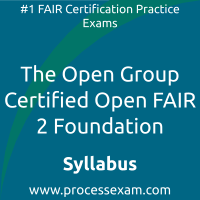 To achieve the professional designation of The Open Group Open FAIR 2 Foundation from the Open Group, candidates must clear the OGOF-101 Exam with the minimum cut-off score. For those who wish to pass the Open Group Open FAIR 2 Foundation certification exam with good percentage, please take a look at the following reference document detailing what should be included in Open Group Open FAIR 2 Foundation Exam preparation.
To achieve the professional designation of The Open Group Open FAIR 2 Foundation from the Open Group, candidates must clear the OGOF-101 Exam with the minimum cut-off score. For those who wish to pass the Open Group Open FAIR 2 Foundation certification exam with good percentage, please take a look at the following reference document detailing what should be included in Open Group Open FAIR 2 Foundation Exam preparation.
The Open Group OGOF-101 Exam Summary, TOGAF Body of Knowledge (BOK), Sample Question Bank and Practice Exam provide the basis for the real The Open Group Certified Open FAIR 2 Foundation exam. We have designed these resources to help you get ready to take The Open Group Open FAIR 2 Foundation (OGOF-101) exam. If you have made the decision to become a certified professional, we suggest you take authorized training and prepare with our online premium Open Group Open FAIR 2 Foundation Practice Exam to achieve the best result.
Open Group OGOF-101 Exam Summary:
| Exam Name | The Open Group Open FAIR 2 Foundation |
| Exam Code | OGOF-101 |
| Exam Fee | USD $395 |
| Exam Duration | 60 Minutes |
| Number of Questions | 40 |
| Passing Score | 60% |
| Format | Multiple Choice Questions |
| Schedule Exam | Pearson VUE |
| Sample Questions | Open Group Open FAIR 2 Foundation Exam Sample Questions and Answers |
| Practice Exam | The Open Group Certified Open FAIR 2 Foundation Practice Test |
Open Group Open FAIR 2 Foundation Syllabus Topics:
| Topic | Details |
|---|---|
| Open FAIR Body of Knowledge Overview |
The Candidate is able to … - Describe the purpose of the Risk Analysis (O-RA) Standard. - Describe the purpose of the Risk Taxonomy (O-RT) Standard. |
| Terminology |
The Candidate is able to … - Define Open FAIR terms:
|
| Basic Risk Concepts |
The Candidate is able to … - Briefly explain each of the five (5) components of risk assessment approaches:
- Describe “scoping” an analysis.
- Explain the limitations of risk-related data. - Differentiate between risk management and risk assessment.
- Differentiate between risk assessment and risk analysis.
- Explain the importance of a tightly defined taxonomy.
- Identify and order the components of the “risk management stack”.
|
| Risk Taxonomy |
The Candidate is able to … - Explain risk, how it is measured, and from which perspective. - Identify the elements of the Open FAIR risk taxonomy.
- Describe the distribution of Open FAIR risk factors.
- Explain estimating risk:
- Explain Loss Event Frequency (LEF):
- Explain Threat Event Frequency (TEF):
- Explain Contact Frequency (CF):
- Explain Probability of Action (PoA):
- Explain Vulnerability (Vuln):
- Explain Threat Capability (TCap):
- Explain Resistance Strength (RS):
- Explain Loss Magnitude (LM):
- Explain the six (6) forms of loss and give an example of each:
- Explain Primary Loss:
- Explain Secondary Loss:
- Explain Loss Factors:
- Explain the two (2) Asset Loss Factors and their subcomponents:
- Explain the three (3) Threat Loss Factors and their subcomponents.
- Explain the four (4) Organizational Loss Factors and their subcomponents:
- Explain the five (5) External Loss Factors:
|
|
Risk Measurement
|
The Candidate is able to … - Explain that risk models are estimates based on available information and inaccurate models. - Explain Accuracy, Precision, Subjectivity, and Objectivity and the differences between:
- Explain Estimating:
- Explain Calibration:
- Explain the Monte Carlo Simulation |
| Risk Analysis Methodology and Process |
The Candidate is able to …
- Explain the risk analysis methodology and process:
- Identify the components of the Loss Scenario:
- Explain the components of a Loss Scenario:
- Explain limiting the scope of the Loss Scenario:
- Explain Evaluating the Loss Event Frequency:
- Explain Estimating Threat Event Frequency:
- Explain Estimating Vulnerability:
- Explain Evaluating the Loss Magnitude:
- Explain Deriving and Articulating Risk:
- Explain Modeling the Effect of Controls:
- Explain Avoidance Controls:
- Explain Deterrent Controls:
- Explain Vulnerability Controls:
- Explain Responsive Controls:
- Explain mapping Open FAIR Controls to other Security Assessment Frameworks:
- Explain putting it all together.
|
| Risk Analysis Quality Considerations |
The Candidate is able to … - Explain documenting assumptions and rationale:
- Explain diminishing returns:
- Explain capacity for loss and tolerance for loss:
- Explain risk qualifiers:
- Explain using ordinal scales for analysis:
- Explain translating quantitative results into qualitative statements:
- Explain troubleshooting an analysis:
|
| Open FAIR Certification Program |
The Candidate is able to … - Explain the Open FAIR Certification Program. - Differentiate between the levels of certification. |
Both Open Group and veterans who’ve earned multiple certifications maintain that the best preparation for a Open Group OGOF-101 professional certification exam is practical experience, hands-on training and practice exam. This is the most effective way to gain in-depth understanding of Open Group Open FAIR 2 Foundation concepts. When you understand techniques, it helps you retain Open Group Open FAIR 2 Foundation knowledge and recall that when needed.
